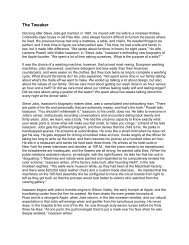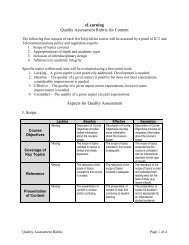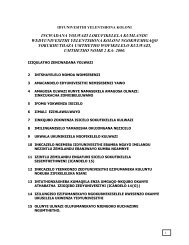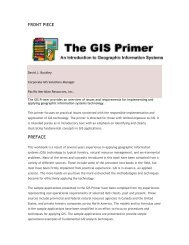Ecosystem Guidelines for Environmental Assessment
Ecosystem Guidelines for Environmental Assessment
Ecosystem Guidelines for Environmental Assessment
Create successful ePaper yourself
Turn your PDF publications into a flip-book with our unique Google optimized e-Paper software.
NICK HELME<br />
LOWLAND FYNBOS<br />
Leipoldtville Sand Fynbos, and Graafwater Sandstone Fynbos dominating the higher ground.<br />
What are the critical things to maintain in terms of managing these<br />
systems <strong>for</strong> biodiversity, and ensuring its persistence<br />
Manage these systems to maintain the appropriate fire regime and to prevent overgrazing, invasion<br />
by alien plant species and over abstraction of groundwater.<br />
Development should be avoided and strongly discouraged in habitat associated with Critically<br />
Endangered and Endangered ecosystems or species, particularly in corridors and vegetation boundaries.<br />
Maintain ecotones that bracket edaphic boundaries, e.g. the interfaces between limestone-sandstone<br />
or limestone-shale.<br />
What, if any, reliable indicators could be used in monitoring ecosystem<br />
health, as related to key vulnerabilities<br />
The density of alien invasives, i.e. there are no dense stands, isolated plants are being controlled,<br />
and biocontrols are present.<br />
The type, age and condition of indigenous plant cover, species richness and the presence of key guilds<br />
(serotiny, woody shrubs, winter annuals). Adherence to appropriate fire regimes can be reflected in<br />
senescence of indigenous vegetation in strip-ploughed lands (burns are too infrequent) or invasion by<br />
grasses and weedy species such as slangbos Stoebe spp. and Aspalathus spp. (burns that are too<br />
frequent, or unseasonal).<br />
The abundance and distribution of populations of Red and Orange List species.<br />
The maintenance of natural water tables, especially adequate winter recovery, should be monitored<br />
(ideally by the Department of Water Affairs and Forestry in vulnerable areas such as the Sandveld).<br />
42 : LOWLAND FYNBOS ECOSYSTEMS
















